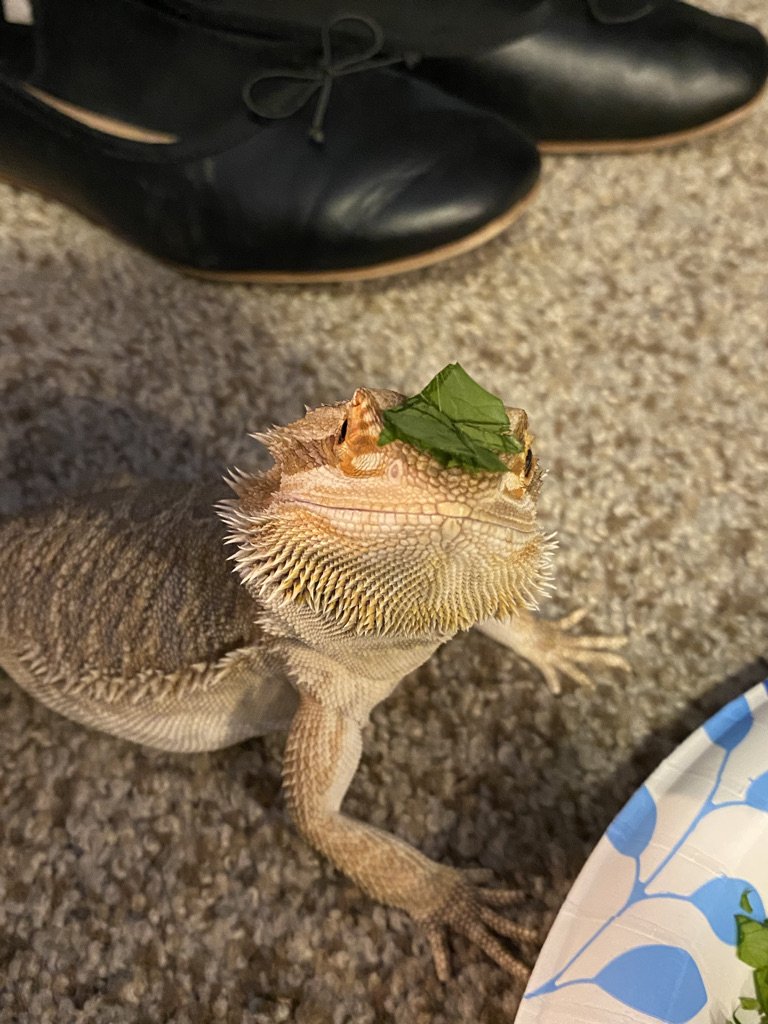Emilee Brewer
Reptiles are fascinating creatures that come in a variety of shapes and sizes. They all have their own unique needs, and they’re just as full of personality as a cat or dog! I have a crested gecko named Poseidon and a bearded dragon named Stanley Yelnats, and both of them have their own unique personality. But despite both being reptiles, they have extremely different needs in terms of enclosure, humidity, and heat. They have different tolerances for handling, too. Stanley is a desert animal while Poseidon is a tropical animal, so their needs are very unique to their species! What goes into reptile care, and how do you choose the right one for you? This week, we’re shifting gears and taking a look at our scaly buddies!
A snake is going to need a different enclosure than a bearded dragon, and a bearded dragon is going to need a different humidity level than a chameleon, and so on and so forth. Reptiles are a little more involved than cats or dogs. Some reptiles are much more difficult than others (looking at you, chameleons), but there are a few good starter reptiles!
Starting off, one of the most common reptiles is a leopard gecko. Growing to about 7-11 inches long, these feisty little lizards are fairly easy to care for. They’re awesome beginner reptiles because they tolerate handling a lot better than others and they have a calm disposition. Leopard geckos are fascinating and have the sweetest personalities. With proper care, they can live anywhere from 10-20 years! For juvenile leos, the recommended tank size is 10 gallons while adults require a 20+ gallon tank. They also need special lighting. Like all reptiles, leopard geckos are exothermic which means they rely on an external heat source to regulate their body temperature. They’ll need a heat source and a UV bulb to maintain the correct temperature in the tank and help them metabolize vitamin D. Leopard geckos are native to semi-arid deserts in the Middle East and parts of northern India. This means they don’t require a lot of humidity; ideally, keep the humidity below 50%. Leos are insectivores which means they feed on bugs! They eat crickets, mealworms, superworms, hornworms, and wax worms.
Leopard geckos store extra nutrients and fat in their tails as an emergency energy source. They can actually detach their tails if they get caught by a predator. It continues to wiggle for a brief period after falling off to distract the predator. Their tail does grow back, but it will never quite look the same as the original. Fun fact, leopard geckos scream. It sounds like a tire deflating, and I love it so much. They come out of the egg screaming, and it is the funniest thing to witness.
Next up is the crested gecko also called the eyelash crested gecko because it looks like they have little eyelashes. These are my favorite geckos because there is not a single thought in their little head. Lights are on, but no one’s home. I cannot stress enough how much I love these guys and how dumb they are. I’ll be watching Poseidon in his tank and he’ll just jump straight at the door and fall. Crested geckos are arboreal and native to New Caledonia. They were actually believed to be extinct until they were rediscovered in 1994! Now they’re a thriving species and one of the most popular beginner reptiles. Cresteds live about 15-20 years with proper care and grow to about 5-8 inches long including their tail. While they don’t tolerate handling as well as their leopard counterparts, they are still fascinating to watch. You can slowly acclimate them to handling but limit handling to about 10-15 minutes a day. Too much handling and they can become stressed.
Cresteds don’t need as much heat as many other reptiles. They can typically kept in a room-temperature tank with a heating mat to provide a little extra warmth if they get chilly. The best setup is to have a gradient. Poseidon is in a vertical 20-gallon tank, and I’ve got two small heating pads on one side of his tank. He can go to that side to warm up and then go to the opposite side or climb up to the top to cool down. On the warm side, it’s around 75 degrees and the cool side is about 68 degrees. Cresteds also need a much higher humidity level than leopards. You can easily use a spray bottle to mist the cage occasionally throughout the day. Humidity should not drop below 50% and should ideally be kept around 80%. They also need a UVB bulb to help with vitamin absorption.
When it comes to feeding, the easiest method is crested gecko diet. Crested gecko diet has all the essential fats, proteins, minerals, and vitamins already mixed in. It’s a combination of fruits and bugs made into a fine powder. Add a little bit of water to make a smoothie and voila! A lovely little slushy for your gecko to eat to its heart’s content.
Just like leopard geckos, cresteds can drop their tails, but unlike leopard geckos, cresteds don’t regrow them. A crested is extremely hesitant to drop its tail and will usually only do it if its tail gets caught in a door or gets pinched. Unless you’re mishandling them, they won’t drop their tail from being held. Fun fact, cresteds have no eyelids! They have to lick their eyes to maintain moisture. They also chirp!
Another fantastic starter reptile is the bearded dragon. Stanley is so full of sass, but he absolutely loves me. All the techs at my vet are amazed by how bonded he is to me. There’s lots of debate in the reptile community if reptiles have emotions, but if you ask me, they definitely have favorite humans. When Stanley was a baby, he would curl into my elbow and fall asleep. If my dad is near him though? He just stares or walks away. So I think reptiles have emotions. Anyway! Dragons live about 10-15 years and grow to about 20 inches long with their tail. Dragon enclosures are a little more involved than cresteds or leopards. A dragon needs lots of space. While they’re little, they can be in a 20-gallon tank, but it truthfully won’t last them long. Bearded dragons grow fast in the first few months. They constantly shed as they grow so rapidly. It’s insane how quickly they grow. Stanley is three years old, about 20 inches long, and he’s in a 40-gallon tank which is the smallest recommended tank size. However, he’s allowed to free roam while I’m home, so he gets the whole apartment to explore. The tank is mostly there for sleeping and warming up.
For lighting, they need a UVB, UVA, and basking bulb. They need a gradient similar to a crested. On the hot end of Stanley’s tank, it’s about 90-95 degrees and the cool end is about 80 degrees. Beardies hail from Australia so they’re used to hot hot temperatures. Dragons are omnivores so they eat bugs and plants. When they’re juveniles, they eat a 70% insect diet and a 30% plant diet. As they mature, those numbers flip flop. Adults get more veg and fewer bugs. Stanley gets a nice salad of kale, collard greens, and mustard greens. As a treat, he’ll get some strawberries or bell peppers. On his bug days, he’ll get superworms or his favorite, dubia roaches. Always research what veggies and fruits are safe for your dragon before feeding them! Certain veggies can hurt them and prevent mineral and vitamin absorption. Dragons are loved as a beginner pet as they are super chill and tolerate handling really well. Fun fact, as a way to show submission, bearded dragons will wave! If they’re showing dominance, they’ll bob their head and their beard will turn black!
Reptiles are super cool animals but they do require lots of research. Also, I’m not going to lie to you, reptiles are kind of pricey. You can usually get the animal itself at a decent price, but the enclosures and lighting get quite expensive! Both of my reptiles are missing legs, so they were discounted, but between the two of them, I have about $400-$500 in their enclosures. It’s not a cheap hobby, but it is extremely rewarding. I got Stanley and Poseidon as babies and it’s been so incredibly fulfilling seeing them grow and thrive. Poseidon jumps to me as soon as I open his tank and Stanley starts begging to be let out as soon as I get home from work. They’re incredible animals and I’ve loved seeing their personalities shine!
Just like picking a dog or a cat, picking a reptile isn’t easy. Make sure you do plenty of research and most importantly, make sure there’s an exotic vet near you! Not all vets see reptiles, so you have to be sure there’s an exotic vet that can get your animal in. Understand that there are easier reptiles than others. The three I’ve listed here are beginner-friendly, but still have a lot of upkeep. Other reptiles though, like chameleons, are absolutely not beginner-friendly. Do not get a chameleon as your first reptile, I cannot stress that enough. They need super specific lighting, and humidity, they don’t like to be handled, everything stresses them out, and they die so easily. I love chameleons, I really do. I hope to own one one day, but they are expert-level reptiles because they are so hard to maintain. Please do lots of research on any animal, but especially reptiles.
Reptiles are incredible animals and they are deserving of our love and respect just like their furry counterparts. I know they’re not everyone’s cup of tea, but give them a chance! I promise they’re not as scary as they seem! If you ever catch me at the kennel, I’m always willing to talk about my boys and show off pictures. I also have audio of Poseidon chirping!





